14 March 2022: Database Analysis
Studies Related to Ruptured Abdominal Aortic Aneurysms in the Past 10 Years (2011–2020): A Bibliometric Analysis
Biyun TengDOI: 10.12659/MSM.935006
Med Sci Monit 2022; 28:e935006
Abstract
BACKGROUND: Ruptured abdominal aortic aneurysms have been a topic of common global interest for the past 20 years, with a steadily increasing number of publications. The purpose of this study was to explore the research themes and the current status of the last 10 years through a bibliometric analysis of the publications in this field.
MATERIAL AND METHODS: We performed a literature search for ruptured abdominal aortic aneurysms using the Web of Science Core Collection on November 14, 2021 and performed a bibliometric analysis and visualization of the results of the publications using the R-Bibliometrix package and VOSviewer software.
RESULTS: From 2011 to 2020, 2381 publications were retrieved, including 2073 articles and 308 reviews. The United States had the highest number of publications and has made a large contribution to the field. Jonathan Golledge is an important researcher with the highest number of publications. Journal of Vascular Surgery is ranked first in terms of the number of publications and local citations. Mortality and outcomes, repair treatment, and risk factors are the 3 main focuses in the field, followed by intraluminal thrombus and molecular expression.
CONCLUSIONS: Our bibliometric analysis suggests mainstream research is focused on clinical studies related to the surgical approach and its prognosis and on pathological mechanisms and hemodynamic studies related to risk factors for abdominal aortic aneurysms rupture. There are many other opportunities for future research in the clinical joint basis of abdominal aortic aneurysms rupture.
Keywords: Rupture, abdominal aortic aneurysms, Bibliometric analysis, Aneurysm, Ruptured, Aortic Aneurysm, Abdominal, Bibliometrics, Global Health, Humans, Incidence, Risk Factors, Vascular Surgical Procedures
Background
Abdominal aortic aneurysm (AAA) is a permanent irreversible aneurysmal dilatation of the abdominal aorta as a pathological lesion larger than 30 mm or more than a 50% increase in diameter [1]. Most AAAs are asymptomatic and are detected during physical examination or ultrasound screening, and rupture or threatened rupture occurs when patients present with symptoms such as lumbar abdominal pain, with an in-hospital mortality rate of approximately 40% [2], while the mortality rate for out-of-hospital AAA rupture can be as high as 90% [3]. Although the management of AAA has evolved rapidly in recent years, and technological advances have transformed the diagnosis and treatment of this disease [4], AAA rupture remains a significant threat for patients [5]. To reduce the risk of AAA rupture, an increasing number of studies have focused on the rupture of AAA, including clinical correlation studies [6–8] and pathological mechanism studies [9,10] throughout the past few decades, but locating significant and essential papers within the ever-expanding literature can be challenging. Therefore, a citation analysis, known as a bibliometric analysis, can be used to quantitatively evaluate and rate articles or journals in a field based on the number of citations it received, as well as to rank journals by impact.
Bibliometric analysis is an overall analysis of the published literature in a specific research area over a specific time frame [11–13]. Compared with traditional systematic evaluation, bibliometric analysis focuses on the institution, authorship, and social structure of the literature, providing a timely and intuitive method to explore specific areas [14]. Previously, various diseases have been studied using bibliometric indicators [15,16]. Bibliometric analysis allows assessment of the main progress made and future research directions in the field of AAA rupture research in the past. Therefore, the purpose of this study was to explore the research characteristics and development trends of research on AAA rupture in the past 10 years through bibliometric analysis, provide an overview of authors, journals, literature orientation, and global situation of the field, and to highlight the latest research hotspots to provide reference for related studies.
Material and Methods
The literature search was conducted on November 14, 2021 using the Web of Science Core Collection (WoSCC), one of the most widely used sources for bibliometric analysis in various fields [17–19]. WoSCC is the authoritative citation index database that allows searching high-level journals. By scanning the complete citation network [20], we can easily analyze and improve the obtained search results based on its provision of high-quality information resources and analytical tools. To avoid daily update bias, literature data were searched within 1 day. The search string was as follows: TOPIC: (“abdominal aortic aneurysm*” OR AAA) AND TOPIC: (*rupture*). The search yielded 5523 publications in the title, abstract, keywords, and their derivatives. The publication period was 2011–2020, and the article types were limited to articles and reviews (n=2390). There were no language restrictions. In this process, 2 researchers reviewed abstracts of articles and cross-checked them. When disagreements were encountered, a third researcher participated in the discussion and made a decision. Finally, 9 irrelevant articles were excluded. We finally exported the full records of 2381 articles with cited bibliographies from WoSCC for subsequent analysis. The screening flowchart is shown in Figure 1.
The journal impact factor (IF) and journal citation reports (JCR) category of each journal were retrieved from JCR™ 2020, the most common reference standard for assessing journal performance in their field. The research areas were derived from analyzing results in WoSCC. GraphPad Prism (version 8.5, San Diego, CA, USA) was used to build present annual global publication and citation trends.
All records were analyzed bibliometrically using the “Bibliometrix” package in R (version 4.1.0) and VOSviewer (version 1.6.16, Leiden University, Netherlands) software. The “Bibliometrix” package automatically transforms and analyzes the selected bibliographic information, including country, author, journal distribution, citations, and author’s indices (h-index, g-index, and m-index). H-index means “high citations”; a researcher’s h-index means that he or she has at most h papers cited at least h times; this index is used to assess the academic contributions and future scientific achievements of a researcher, journal, and country [21]. Local citations (LCS) measures the number of times an author, journal, or paper included in the collection is cited by other authors also included in the collection [22].
A co-occurrence analysis of keywords was performed using VOSviewer (version 1.6.16, Leiden University, Netherlands) software, where network, overlay, and density visualizations present keywords with more than 20 occurrences to identify important terms.
Results
OVERALL STATISTICS:
A total of 2381 publications (2011–2020) related to ruptured AAA were retrieved in WoS. All the publications had 3188 keywords, total citation frequency totaling 41 868, excluding 31 887 self-citations, and an h-index of 77. Publications came from 526 sources and 55 countries, with English as the main language type (2328/2381, 97.77%). There were 2073 articles (2073/2381, 87.06%) and 308 reviews (308/2381, 12.94%), with a ratio of articles to reviews of 6.73: 1. The number of publications increased from 181 to 277 and annual citations increased from 139 to 7369 in 2011–2020, with an average annual growth rate of 4.8% and 55.45%, respectively (Figure 2).
COUNTRIES AND AUTHORS:
In terms of countries, the UK, the USA, Germany, Netherlands, and Sweden had 20, 18, 17, 17, and 16 output flow rates, respectively, showing relatively major institutional contributions, while the USA ranks first in terms of number and linkage across units combined. James Cook University, University of Kentucky, University of Cambridge, University of Toronto, and Erasmus University are the major contributing institutions. Of these, James Cook University had a total of 560 publications and presents major contributing affiliations with 9 countries and 9 authors (Figure 3).
We visualized the global contribution of studies related to ruptured AAAs (Figure 4A). Among 55 countries, the USA had the highest number of published articles, with 537 (22.55%), followed by the UK, Netherlands, Germany, and China, with 249 (10.46%), 159 (6.68%), 144 (6.05%), and 142 (5.96%), respectively; these countries accounted for more than half of the published articles.
The corresponding author countries were mostly dominated by domestic publications, with the number ranging from 0 to 443, with single-country publications (SCP) ratios up to 82.50%, 75.10%, 72.96%, 68.06%, and 83.10% for the USA, UK, Netherlands, Germany, and China, respectively. China had the highest SCP ratio of publications in the top 5 countries. Among the top 20, only Belgium had more multinational publications than single-country publications (16/13), indicating a low rate of international cooperation in the countries of corresponding authors (Figure 4B).
In terms of the number of publications (Table 1), Jonathan Golledge from Queensland Research Centre and James Cook University was the most prolific author, with 34 articles (1.43%), and Janet T Powell was the next highest, with 32 (1.34%) publications, followed by Martin Bjorck (27, 1.13%), A. Wanhainen (27, 1.13%), and Yu Wang (26, 1.09%). In terms of publication h-index, Janet T. Powell and Michael J. Sweeting were tied for first place, both with 20. In terms of LCS, Michael J Sweeting (253) published the most cited publication out of 2318 publications, followed by Marc L Schermerhorn (202). Michael J Sweeting has been recognized by more scholars in the field of AAA rupture.
JOURNALS, FIELDS, AND LITERATURE:
In the field of ruptured AAAs, there were 2381 publications in 526 journals. The top 10 journals in terms of productivity are listed in Table 2, with the Journal of Vascular Surgery publishing the most articles (258), accounting for 10.84% of all articles, followed by Annals of Vascular Surgery (210, 8.82%), European Journal of Vascular and Endovascular Surgery (171, 7.18%), Journal of Endovascular Therapy (93, 3.91%), and Vascular (58, 2.44%). In terms of LCS (Table 2), the Journal of Vascular Surgery (15 596), European Journal of Vascular and Endovascular Surgery (6689), British Journal of Surgery (2892), Circulation (2698), and Arteriosclerosis, Thrombosis, and Vascular Biology (2147) were represented by the Journal of Vascular Surgery, which ranked first in both publications and local citations. Surgery, cardiovascular systems, and cardiology are the areas represented by these journals.
Publications totaled 67 research areas, with cardiovascular system cardiology (1311, 55.06%) and surgery (1129, 47.42%) being the most represented areas in these journals, followed by engineering (194, 8.15%), radiology nuclear medicine medical imaging (147, 6.17%), and general internal medicine (137, 5.75%) (Table 3).
The top 20 articles ranked by LCS are shown in Figure 5A. The most cited article is “Endovascular Repair Versus Open Repair of Ruptured Abdominal Aortic Aneurysms
A Multicenter Randomized Controlled Trial”, which was published in the Annals of Surgery in 2013. This article had an LCS of 138, 229 global citations (GC), an LCS/GC ratio of 60.26%, and a normalized LCS of 32.36, indicating that it is the most valuable publication in recent years (Figure 5B). This article showed there was no significant difference in mortality and severe complications between endovascular repair and open repair in ruptured AAA [23]. Figure 4B shows the top 20 most relevant historical direct citations in the field of AAA rupture concerning time and cross-referencing. The most valuable article in 2011 was published in Circulation: “Predictors of abdominal aortic aneurysm sac enlargement after endovascular repair” [24].
POPULAR RESEARCH ANALYSIS: KEYWORDS AND HOTSPOTS:
We extracted keywords that appeared more than 20 times in the title and abstract by use of VOSviewer software, removed keywords related to the main search terms, and merged the consistent keywords. Finally, we analyzed a total of 114 keywords. The keywords in Figure 6A are divided into 5 clusters. Cluster 1 (red) has more keywords appearing in the outcomes (381), endovascular repair (323), management (235), endovascular repair (EVAR) (158), and stent-graft (123). Cluster 2 (green) has more keywords appearing in risk factors (394), growth (156), expression (104) and inflammation (91). Cluster 3 (blue) has more keywords appearing in repair (425), mortality (382), meta-analysis (237), randomized-trial (161) and surveillance (131). Cluster 4 (yellow) has more keywords appearing in intraluminal thrombus (157), model (139), diameter (133), wall stress (131), and prediction (107). Cluster 5 (purple) has more keywords appearing in open repair (197), trial (147), and survival (112). In general, all research areas are focused on 2 directions: the first one is clinical research related to surgical modality and its prognosis, including red, green, and purple clusters; the other one is the pathological mechanism and biomechanical research related to risk factors, including green and yellow clusters. Over time, research has evolved from randomized-trial, repair including endovascular repair in the beginning to the risk factors and mortality of AAA. In the present study, outcomes, women, prediction, and oxidative stress of the AAA rupture are the main points (Figure 6B). Among them, mortality and outcomes, repair treatment, and risk factors are the 3 main focuses in the field of AAA rupture (Figure 6C). This is followed by intraluminal thrombus and molecular expression.
Discussion
This study used VOSviewer and Bibliometrix software to perform and visualize bibliometric analysis of 2381 articles and reviews in the field of ruptured AAAs in the last 10 years, providing in-depth information on the ranking and contribution of countries, institutions, authors, journals, fields, and keywords in the field. In WOS, the first article in this field was published by Soisalon-Soininen [25] in 1999, and the annual number of articles in this field has steadily increased over the last decade, accounting for 55.11% of the total articles searched, with a ratio of articles to reviews of 6.73: 1. In addition, the total citation frequencies were 41 868 and annual citations increased from 139 in 2011 to 7369 in 2020, which indicated a tremendous increase in interest in this field.
Among the global contributions, the USA has the most publications and is the most prolific country in terms of ruptured AAAs, with the Journal of Vascular Surgery and Annals of Vascular Surgery being the best journals publishing on the topic, both published in the USA. In addition, although the publications of the corresponding author countries are mostly domestic, there are still a large number of high-scoring studies that explored this field through global data and national collaborations, especially regarding the collection and development of patient information in clinically relevant studies. For example, researchers from Germany, the USA, Spain, and Sweden compared the outcomes of EVAR in nonagenarians vs non-nonagenarians [26], and researchers from the USA, UK, France, and Western Australia explored 20-year mortality of AAA in 21 regions [27]. This means that ruptured AAAs is a topic of common global interest.
This study found that among the top 10 most productive journals with IF <10, all were low-IF journals. This means that publishing articles in this field in high-quality journals is challenging. In contrast, among the top 20 articles with high LCS, 5 were published in the Journal of Vascular Surgery, indicating that the articles in this journal have some breakthroughs and strengths in the field of AAA rupture.
In this study, the top 5 LCS studies were selected for analysis. Reimerink et al [23] published a multicenter randomized controlled trial in Annals of Surgery with the most LCS of 138 in 2013, which showed that in the treatment of ruptured AAAs, EVAR and OR did not differ significantly in terms of combined 30-day mortality and serious complications. In 2018, Chaikof et al [28] published a systematic review in the Journal of Vascular Surgery in 2018 (n=119), which is the Society for Vascular Surgery’s systematic approach to the assessment, treatment, anesthesia, preoperative and postoperative management, and economic benefits. It is one of the most influential new guidelines. In 2011, Schanzer et al [24] published in Circulation a multicenter observational study exploring risk factors for aneurysm sac (LCS, n=106) enlargement after EVAR, which found a high probability of diameter increase after EVAR for AAAs and several independent predictors, including endoleaks, age ≥80 years, aortic neck diameter ≥28 mm, aortic neck angle >60°, and common iliac artery diameter >20 mm, suggesting future research directions for the clinical application of indicators to detect AAA growth. In 2011, Svensjo et al [29] published an article in Circulation that ranked 4th in the LCS (n=101); the article found lower than expected prevalence in this population by screening older Swedish men aged 65 years, suggesting the need for rescreening in higher age groups and selective screening of smokers. In 2011, Nordon et al [30] published a review in Nature Reviews Cardiology (LCS, n=92), which explored AAA as a local representation of the vasculature systemic disease. The review provided a comprehensive and detailed description of the epidemiology of AAA and the risk factors that influence development and treatment outcomes, as well as suggesting that future epidemiological studies should be combined with molecular biology to establish molecular markers or risk factors for AAA rupture to help make a clinical decision. These 5 papers described AAAs in terms of the full spectrum of diagnosis and treatment, outcomes, epidemiology, and screening: 2 papers in Circulation, the 4th ranked journal in the LCS, and 1 paper in the Journal of Vascular Surgery, the top ranked journal in volume.
Figure 6A–6C shows that the hotspots of research on AAA rupture are mainly focused on surgery and its prognosis and in-depth exploration of risk factors, among which the mortality and outcomes of AAA rupture have been the subject and focus of research. In the last 20 years, the morbidity, treatment, and mortality of patients with AAA have been analyzed in different countries, such as the USA [31], Germany [32], the Netherlands [33], the UK [34], Sweden [35], and New Zealand [36]. Morbidity and mortality are enduring themes that vary with time and risk factors. Our keyword analysis revealed that the hot topics related to AAA prognosis are mainly surgery and its modalities, including OR and EVAR. With the development of minimally invasive treatment, EVAR, a new minimally invasive surgical approach for AAA, has led to global research efforts focused on evaluating the effectiveness of both treatments. The results proved that both open repair (OA) and EVAR were safe and effective in treating AAA [23], and the long-term survival rate of OA was higher than that of RVAR, as shown by long-term follow-up [37], and Zhou et al [13] performed an updated literature measurement analysis. At the same time, our results showed that analysis of risk factors for rupture in terms of blood flow and foundation (intraluminal thrombus, flow, wall stress, inflammation, expression, smooth muscle cells) is also a hot topic of current research. Haller et al [38] found that high intraluminal thrombus (ILT) was associated with a high risk of small aneurysm rupture by retrospectively analyzing ILT indices of different states of AAA and hemodynamic parameters derived from finite element analysis-based methods, while the volume of ILT and its rapid increase over time were also risk factors for AAA rupture [39,40]. Boyd et al [41] found that hemodynamic parameter wall shear stress is more likely to cause rupture of AAA at low levels. This implies that hemodynamic analysis is a hot topic in this study, and hemodynamic studies using computational fluid dynamics [42], finite element analysis [43], and fluid-solid coupling [44] have effectively elucidated the risk factors for AAA rupture, such as WSS, peak pressure, oscillatory shear stress index, and relative residence level [45]. Factors such as hemodynamics accelerate the inflammatory response in AAA, and a large number of high-IF journal articles demonstrate that cellular inflammation plays a central role in the pathophysiology, progression, and outcome of AAA [46,47]. On a fundamental level, the small GTP-binding protein GDP dissociation stimulator [48], transcription factor EB [9], sirtuin 1 [47], and the expression of different molecules can inhibit AAA development and rupture and protect against AAA.
In addition, according to Figure 6B, while clinically relevant studies continue to progress, they are being refined to focus on the heterogeneity of different populations, such as octogenarians [49] and women. Among them, women with AAA rupture have a higher risk of death after EVAR or OR [50]. New research methods like geometric-biomechanical [51] and computational mathematics models [52] are also involved, which can be used to predict AAA rupture, including the assessment of elastic and fluid characteristics, and may provide some value for AAA growth and rupture. In addition, proteins related to oxidative stress such as tumor necrosis factor receptor superfamily member 1B, trefoil factor 3, and serum malondialdehyde are potential candidate biomarkers for AAA diagnosis, rupture risk, and prognostic identification [53,54]. These biomarkers and their mechanisms may represent future drug therapeutic targets for AAA.
Based on bibliometric and visual analysis, it is possible to determine the development trends and hot spots in this field. Our analysis has several limitations, similar to other bibliometric analyses [55,56]. First, all of our publications were derived from the WOS database, while other databases, such as PubMed, were not searched, and literature from other databases could not be combined. Second, the keyword analysis in this study was affected by incomplete keyword extraction, and for better visualization of the analysis only keywords with more than 20 occurrences were extracted in this study, which may have ignored the latest research trends due to the high frequency of relevant relationship terms.
Conclusions
Our study shows that the USA, Jonathan Golledge, and Journal of Vascular Surgery have the highest publication volume in the terms of countries, authors, and journals, respectively, with cardiovascular system cardiology being the primary research area. The mainstream of research is focused on clinical studies related to the surgical approach and its prognosis and on pathological mechanisms and hemodynamic studies related to risk factors for AAA rupture. There are many other opportunities for future research in the clinical joint basis of AAA rupture; for example, there have been few studies on pharmacological treatment targets. The application of bibliometric analysis to track the overview of developments in the field of AAA rupture is a contribution to continued in-depth research. We believe that the bibliometric analysis presented in this study can inform subsequent research.
Figures
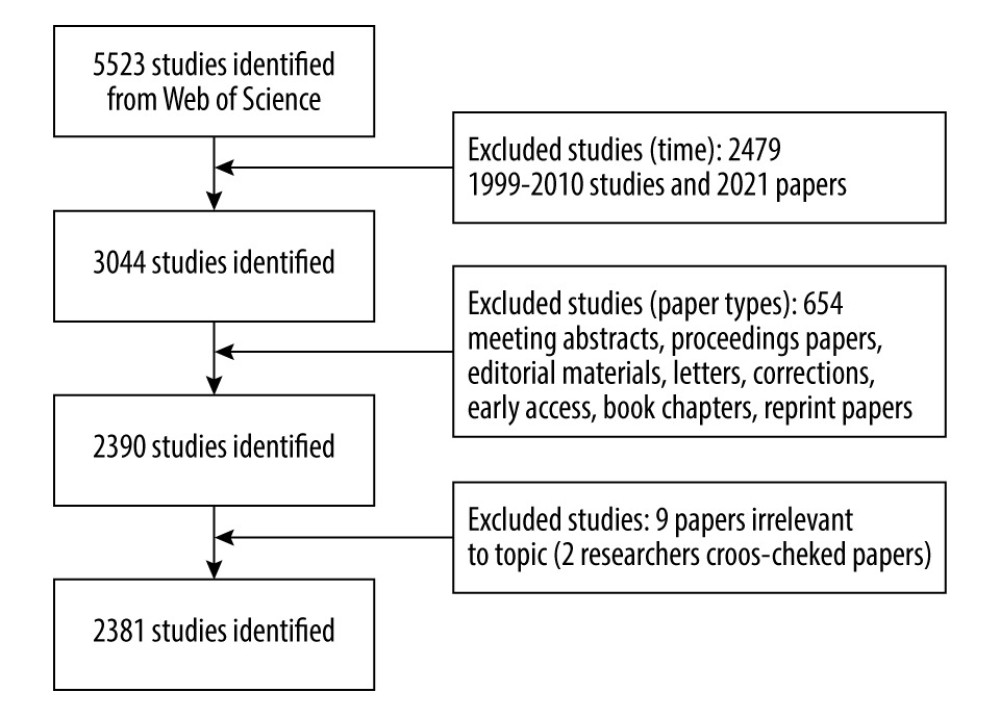 Figure 1. The flowchart of data filtering (Microsoft PowerPoint 2019, version 2110).
Figure 1. The flowchart of data filtering (Microsoft PowerPoint 2019, version 2110). 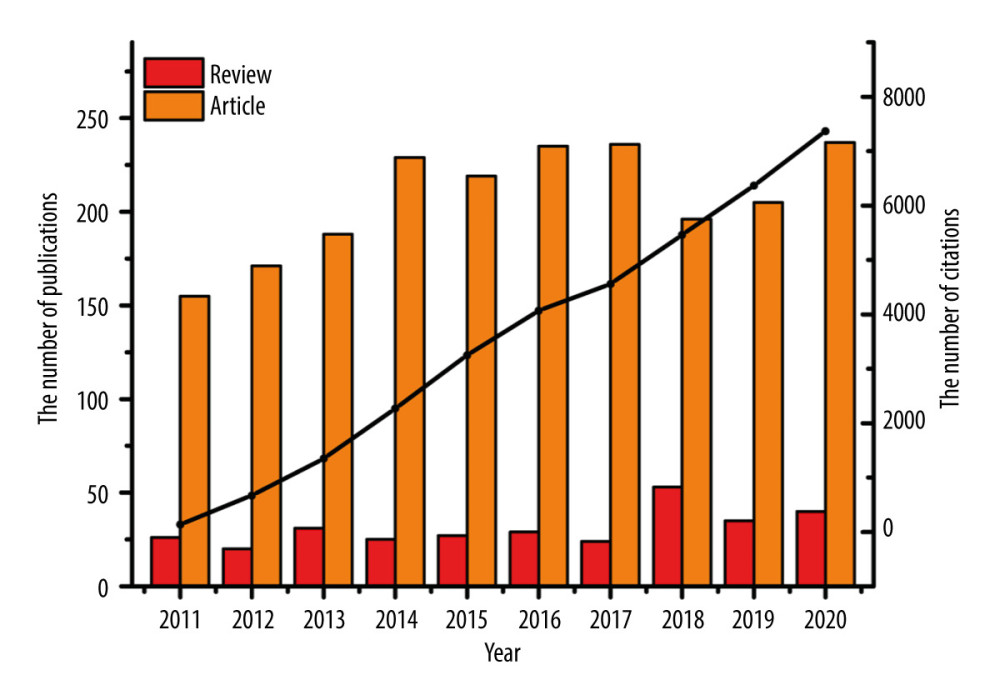 Figure 2. The annual trend of paper publication. Annual publication and citation count for ruptured abdominal aortic aneurysms. The black line shows citations, bar chart represents the number of review and article in 2011–2021 (“Bibliometrix” R package, version 4.1.0).
Figure 2. The annual trend of paper publication. Annual publication and citation count for ruptured abdominal aortic aneurysms. The black line shows citations, bar chart represents the number of review and article in 2011–2021 (“Bibliometrix” R package, version 4.1.0). 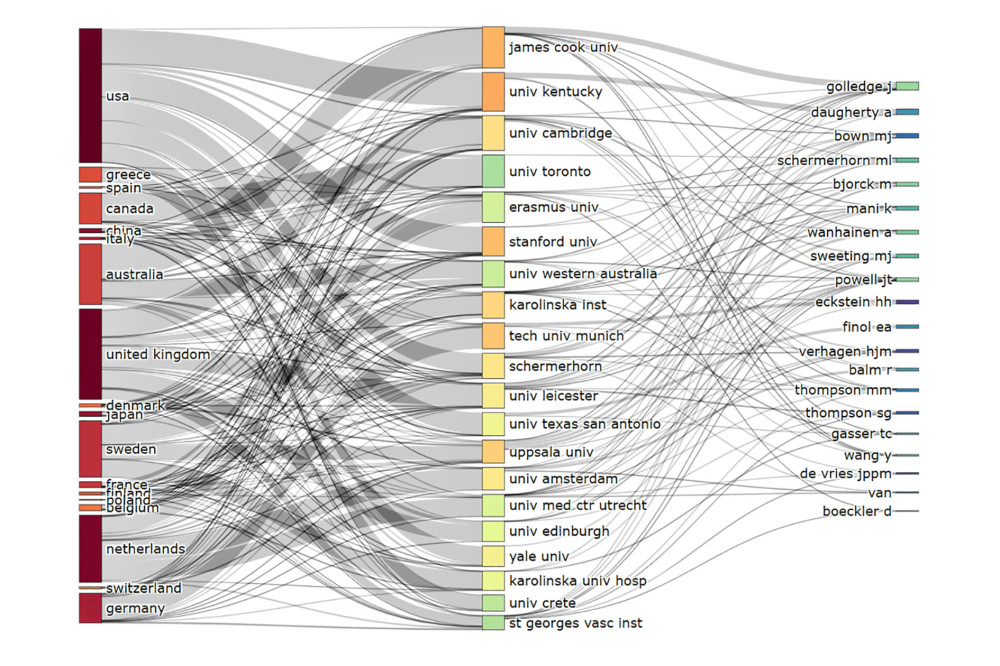 Figure 3. Three Field Plot for the top 20 most productive countries, affiliations and authors (“Bibliometrix” R package, version 4.1.0).
Figure 3. Three Field Plot for the top 20 most productive countries, affiliations and authors (“Bibliometrix” R package, version 4.1.0). 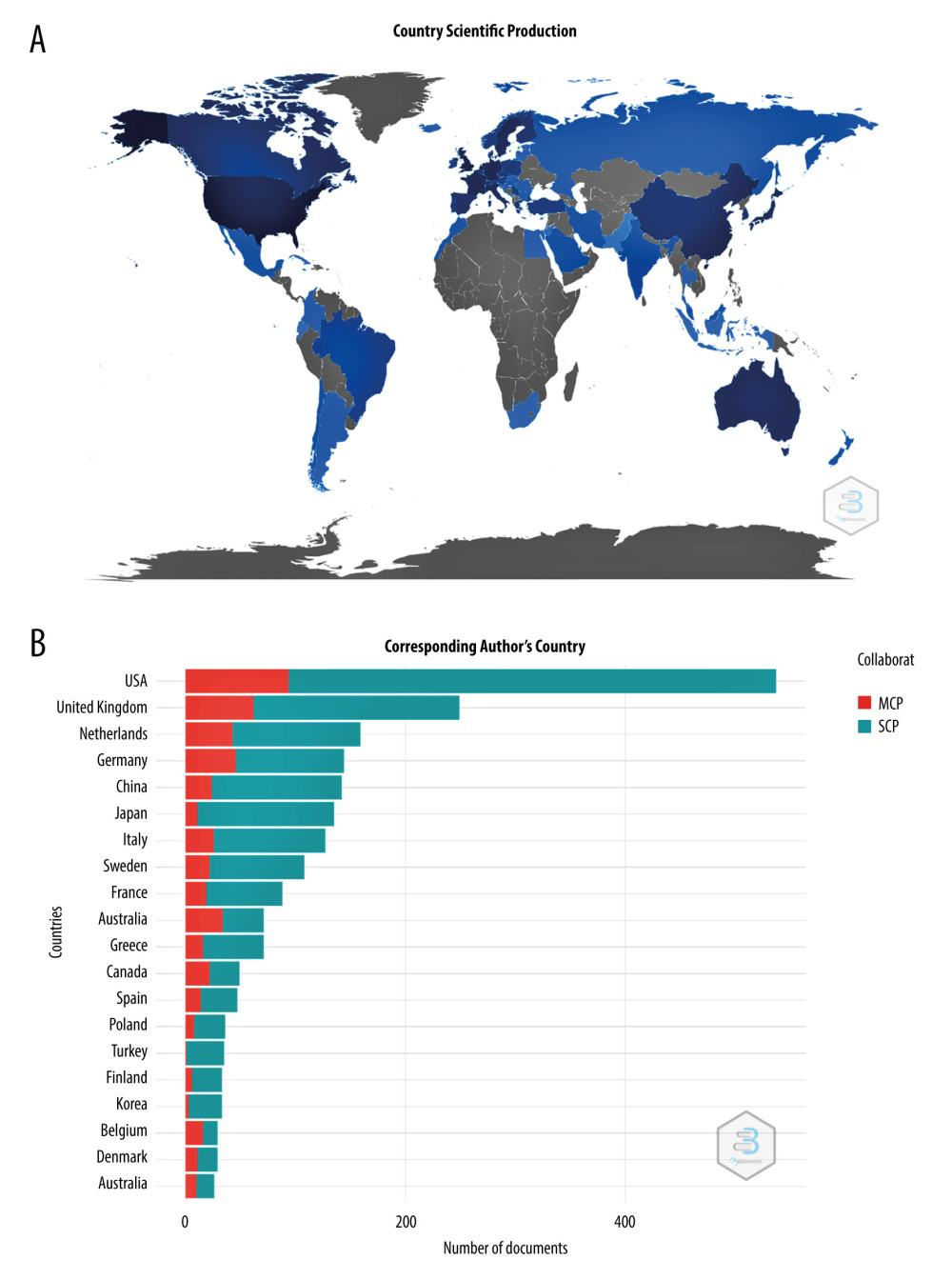 Figure 4. Distribution of countries/regions contributing to abdominal aortic aneurysm rupture (A) and the top 20 corresponding authors’ country (B). SCP – Single-Country Publications; MCP – Multiple Country Publications (“Bibliometrix” R package, version 4.1.0).
Figure 4. Distribution of countries/regions contributing to abdominal aortic aneurysm rupture (A) and the top 20 corresponding authors’ country (B). SCP – Single-Country Publications; MCP – Multiple Country Publications (“Bibliometrix” R package, version 4.1.0). 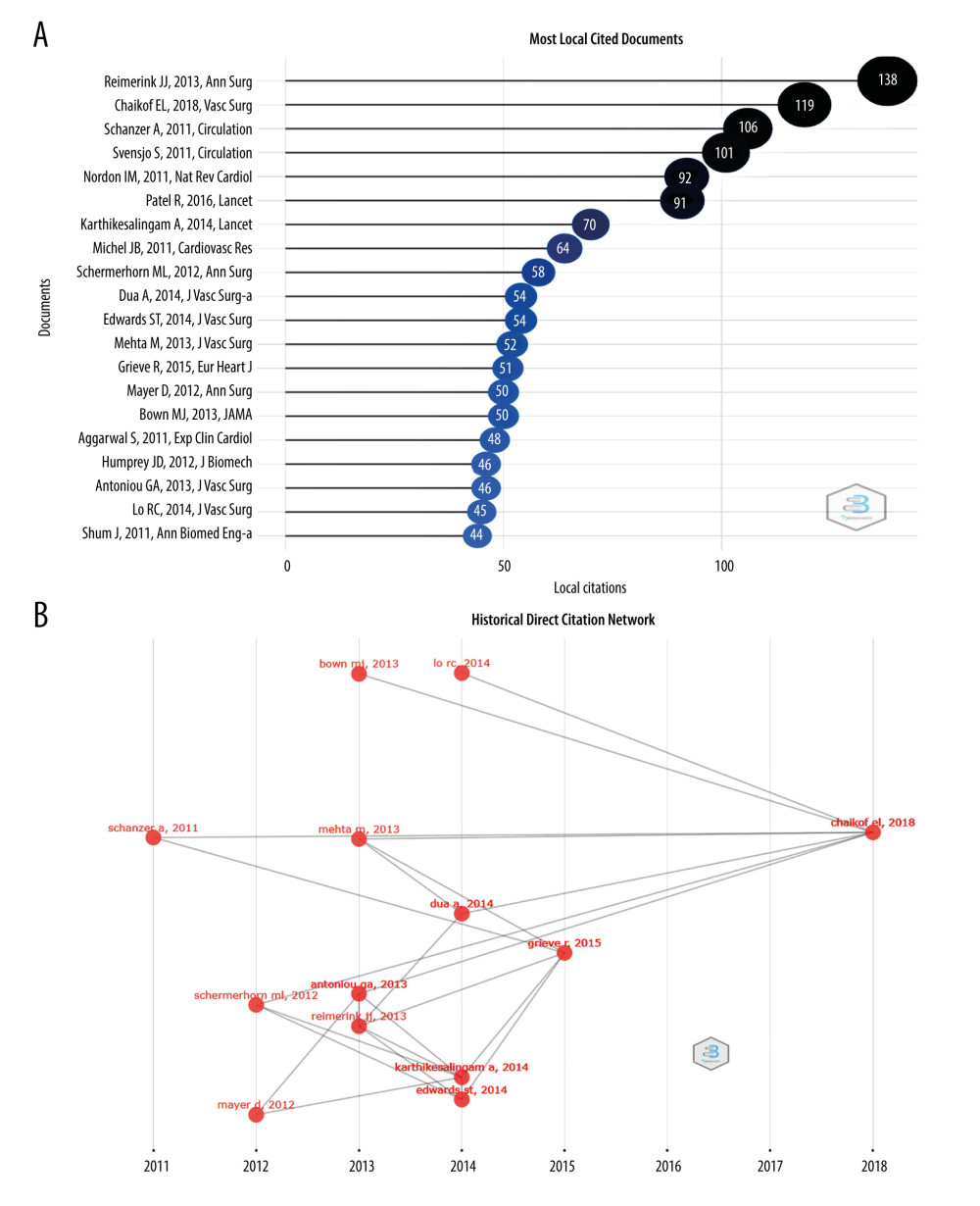 Figure 5. The citation analysis of documents. Top 20 local citations (A) and top 20 historical direct citation (B) articles (“Bibliometrix” R package, version 4.1.0).
Figure 5. The citation analysis of documents. Top 20 local citations (A) and top 20 historical direct citation (B) articles (“Bibliometrix” R package, version 4.1.0). 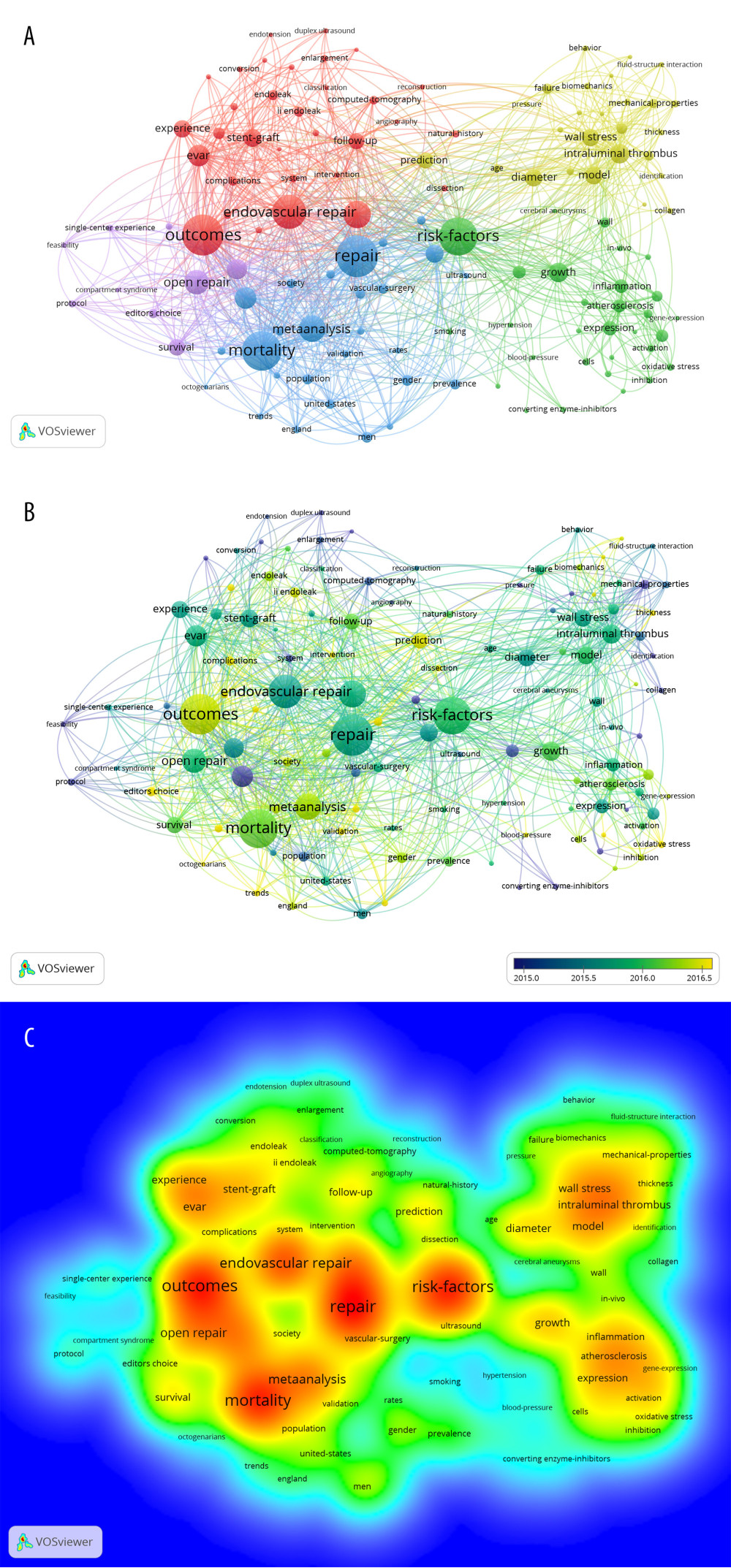 Figure 6. Keyword co-occurrence analysis. (A) Classification of keywords in the AAA rupture field: Cluster 1 (28 items): red; Cluster 2 (27 items): green; Cluster 3 (24 items): blue; Cluster 4 (23 items): yellow; Cluster 5 (12 items): purple. The size of the circle indicates the frequency of occurrence, and the distance of the circle indicates the number of co-occurrences. (B) Average year of publication distribution of keywords; blue indicates more distant keywords, yellow indicates more recent keywords. (C) According to the distribution of keywords with average frequency of occurrence, red indicates the highest frequency of occurrence (VOSviewer, version 1.6.16, Leiden University).
Figure 6. Keyword co-occurrence analysis. (A) Classification of keywords in the AAA rupture field: Cluster 1 (28 items): red; Cluster 2 (27 items): green; Cluster 3 (24 items): blue; Cluster 4 (23 items): yellow; Cluster 5 (12 items): purple. The size of the circle indicates the frequency of occurrence, and the distance of the circle indicates the number of co-occurrences. (B) Average year of publication distribution of keywords; blue indicates more distant keywords, yellow indicates more recent keywords. (C) According to the distribution of keywords with average frequency of occurrence, red indicates the highest frequency of occurrence (VOSviewer, version 1.6.16, Leiden University). References
1. McGregor JC, Pollock JG, Anton HC, The value of ultrasonography in the diagnosis of abdominal aortic aneurysm: Scott Med J, 1975; 20(3); 133-37
2. Kühnl A, Erk A, Trenner M, Salvermoser M, Incidence, treatment and mortality in patients with abdominal aortic aneurysms: Dtsch Arztebl Int, 2017; 114(22–23); 391-98
3. Kent KC, Abdominal aortic aneurysms: N Engl J Med, 2014; 371(22); 2101-8
4. Anagnostakos J, Lal BK, Abdominal aortic aneurysms: Prog Cardiovasc Dis, 2021; 65; 34-43
5. Gurung R, Choong AM, Woo CC, Genetic and epigenetic mechanisms underlying vascular smooth muscle cell phenotypic modulation in abdominal aortic aneurysm: Int J Mol Sci, 2020; 21(17); 6334
6. IMPROVE Trial Investigators, Comparative clinical effectiveness and cost effectiveness of endovascular strategy v open repair for ruptured abdominal aortic aneurysm: Three year results of the IMPROVE randomised trial: BMJ, 2017; 359; j4859
7. IMPROVE Trial Investigators, The effect of aortic morphology on peri-operative mortality of ruptured abdominal aortic aneurysm: Eur Heart J, 2015; 36(21); 1328-34
8. Powell JT, Sweeting MJIMPROVE Trial Investigators, Endovascular or open repair strategy for ruptured abdominal aortic aneurysm: 30 day outcomes from IMPROVE randomised trial: BMJ, 2014; 348; f7661
9. Lu H, Sun J, Liang W, Cyclodextrin prevents abdominal aortic aneurysm via activation of vascular smooth muscle cell transcription factor EB: Circulation, 2020; 142(5); 483-98
10. Cheng J, Zhang R, Li C, Tao H, A targeting nanotherapy for abdominal aortic aneurysms: J Am Coll Cardiol, 2018; 72(21); 2591-605
11. Yeung AWK, Tosevska A, Klager E, Virtual and augmented reality applications in medicine: Analysis of the scientific literature: J Med Internet Res, 2021; 23(2); e25499
12. Wang S, Zhou H, Zheng L, Global trends in research of macrophages associated with acute lung injury over past 10 years: A bibliometric analysis: Front Immunol, 2021; 12; 669539
13. Zhou KZ, Maingard J, Phan K, The 100 most cited articles in the endovascular treatment of thoracic and abdominal aortic aneurysms: J Vasc Surg, 2018; 68(5); 1566-81
14. Zhu H, Zhang Z, Emerging trends and research foci in cataract genes: A bibliometric and visualized study: Front Genet, 2021; 12; 610728
15. Zhang Z, Yao L, Wang W, A Bibliometric analysis of 34,692 publications on thyroid cancer by machine learning: How much has been done in the past three decades?: Front Oncol, 2021; 11; 673733
16. Li T, Yang A, Liu G, Status quo and research trends of craniopharyngioma research: A 10-year bibliometric analyses (from 2011 to 2020): Front Oncol, 2021; 11; 744308
17. Devos P, Menard J, Bibliometric analysis of research relating to hypertension reported over the period 1997–2016: J Hypertens, 2019; 37(11); 2116-22
18. Müller AM, Maher CA, Vandelanotte C, Physical activity, sedentary behavior, and diet-related eHealth and mHealth research: Bibliometric analysis: J Med Internet Res, 2018; 20(4); e122
19. Zhao J, Yu G, Cai M, Bibliometric analysis of global scientific activity on umbilical cord mesenchymal stem cells: A swiftly expanding and shifting focus: Stem Cell Res Ther, 2018; 9(1); 32
20. Birkle C, Pendlebury DA, Schnell J, Adams J, Web of Science as a data source for research on scientific and scholarly activity: Quantitative Science Studies, 2020; 1(1); 363-76
21. Bertoli-Barsotti L, Lando T, A theoretical model of the relationship between the-index and other simple citation indicators: Scientometrics, 2017; 111(3); 1415-48
22. Hao X, Liu Y, Li X, Zheng J, Visualizing the history and perspectives of disaster medicine: A bibliometric analysis: Disaster Med Public Health Prep, 2019; 13(5–6); 966-73
23. Reimerink JJ, Hoornweg LL, Vahl AC, Endovascular repair versus open repair of ruptured abdominal aortic aneurysms: A multicenter randomized controlled trial: Ann Surg, 2013; 258(2); 248-56
24. Schanzer A, Greenberg RK, Hevelone N, Predictors of abdominal aortic aneurysm sac enlargement after endovascular repair: Circulation, 2011; 123(24); 2848-55
25. Soisalon-Soininen S, Salo JA, Perhoniemi V, Mattila S, Emergency surgery of non-ruptured abdominal aortic aneurysm: Ann Chirur Gynaecol, 1999; 88(1); 38-43
26. Prendes CF, Dayama A, Panneton JM, Endovascular aortic repair in nonagenarian patients: J Am Coll Cardiol, 2021; 77(15); 1891-99
27. Sampson UK, Norman PE, Fowkes FG, Global and regional burden of aortic dissection and aneurysms: mortality trends in 21 world regions, 1990 to 2010: Glob Heart, 2014; 9(1); 171-80e10
28. Chaikof EL, Dalman RL, Eskandari MK, The Society for Vascular Surgery practice guidelines on the care of patients with an abdominal aortic aneurysm: J Vasc Surg, 2018; 67(1); 2-77e2
29. Svensjo S, Bjorck M, Gurtelschmid M, Low prevalence of abdominal aortic aneurysm among 65-year-old Swedish men indicates a change in the epidemiology of the disease: Circulation, 2011; 124(10); 1118-23
30. Nordon IM, Hinchliffe RJ, Loftus IM, Thompson MM, Pathophysiology and epidemiology of abdominal aortic aneurysms: Nat Rev Cardiol, 2011; 8(2); 92-102
31. Melillo AM, Trani JL, Gaughan JP, Assessing trends, morbidity, and mortality in ruptured abdominal aortic aneurysm repair with 9 years of data from the National Surgical Quality Improvement Program: J Vasc Surg, 2020; 71(2); 423-31
32. Kuhnl A, Erk A, Trenner M, Salvermoser M, Incidence, treatment and mortality in patients with abdominal aortic aneurysms: Dtsch Arztebl Int, 2017; 114(22–23); 391-98
33. Nelissen BGL, Herwaarden JA, Pasterkamp G, Shifting abdominal aortic aneurysm mortality trends in The Netherlands: J Vasc Surg, 2015; 61(3); 642-47e2
34. Sidloff DA, Saratzis A, Sweeting MJ, Sex differences in mortality after abdominal aortic aneurysm repair in the UK: Br J Surg, 2017; 104(12); 1656-64
35. Karthikesalingam A, Wanhainen A, Holt PJ, Comparison of long-term mortality after ruptured abdominal aortic aneurysm in England and Sweden: Br J Surg, 2016; 103(3); 199-206
36. Sandiford P, Mosquera D, Bramley D, Trends in incidence and mortality from abdominal aortic aneurysm in New Zealand: Br J Surg, 2011; 98(5); 645-51
37. Patel R, Sweeting MJ, Powell JT, Greenhalgh RM, Endovascular versus open repair of abdominal aortic aneurysm in 15-years’ follow-up of the UK endovascular aneurysm repair trial 1 (EVAR trial 1): A randomised controlled trial: Lancet, 2016; 388(10058); 2366-74
38. Haller SJ, Crawford JD, Courchaine KM, Intraluminal thrombus is associated with early rupture of abdominal aortic aneurysm: J Vasc Surg, 2018; 67(4); 1051-8e1
39. Stevens RRF, Grytsan A, Biasetti J, Biomechanical changes during abdominal aortic aneurysm growth: PLoS One, 2017; 12(11); e0187421
40. Singh TP, Wong SA, Moxon JV, Systematic review and meta-analysis of the association between intraluminal thrombus volume and abdominal aortic aneurysm rupture: J Vasc Surg, 2019; 70(6); 2065-72e10
41. Boyd AJ, Kuhn DC, Lozowy RJ, Kulbisky GP, Low wall shear stress predominates at sites of abdominal aortic aneurysm rupture: J Vasc Surg, 2016; 63(6); 1613-19
42. Joly F, Soulez G, Lessard S, A Cohort longitudinal study identifies morphology and hemodynamics predictors of abdominal aortic aneurysm growth: Ann Biomed Eng, 2020; 48(2); 606-23
43. Singh TP, Moxon JV, Iyer V, Comparison of peak wall stress and peak wall rupture index in ruptured and asymptomatic intact abdominal aortic aneurysms: Br J Surg, 2021; 108(6); 652-58
44. Xenos M, Labropoulos N, Rambhia S, Progression of abdominal aortic aneurysm towards rupture: Refining clinical risk assessment using a fully coupled fluid-structure interaction method: Ann Biomed Eng, 2015; 43(1); 139-53
45. Gao Z, Xiong J, Chen Z, Gender differences of morphological and hemodynamic characteristics of abdominal aortic aneurysm: Biol Sex Differ, 2020; 11(1); 41
46. MA3RS Study Investigators, Aortic wall inflammation predicts abdominal aortic aneurysm expansion, rupture, and need for surgical repair: Circulation, 2017; 136(9); 787-97
47. Chen H-Z, Wang F, Gao P, Age-associated Sirtuin 1 reduction in vascular smooth muscle links vascular senescence and inflammation to abdominal aortic aneurysm: Circ Res, 2016; 119(10); 1076-88
48. Nogi M, Satoh K, Sunamura S, Small GTP-binding protein GDP dissociation stimulator prevents thoracic aortic aneurysm formation and rupture by phenotypic preservation of aortic smooth muscle cells: Circulation, 2018; 138(21); 2413-33
49. Tang GHL, Tadros RO, Endovascular aortic repair in nonagenarians: Select well and time appropriately: J Am Coll Cardiol, 2021; 77(15); 1900-2
50. Pouncey AL, David M, Morris RI, Editor’s choice – Systematic review and meta-analysis of sex specific differences in adverse events after open and endovascular intact abdominal aortic aneurysm repair: Consistently worse outcomes for women: Eur J Vasc Endovasc Surg, 2021; 62(3); 367-78
51. Lindquist Liljeqvist M, Bogdanovic M, Geometric and biomechanical modeling aided by machine learning improves the prediction of growth and rupture of small abdominal aortic aneurysms: Sci Rep, 2021; 11(1); 18040
52. Nana P, Spanos K, Dakis K, Imaging predictive factors of abdominal aortic aneurysm growth: J Clin Med, 2021; 10(9); 1917
53. Memon AA, Zarrouk M, Agren-Witteschus S, Identification of novel diagnostic and prognostic biomarkers for abdominal aortic aneurysm: Eur J Prev Cardiol, 2020; 27(2); 132-42
54. Shi F, Ma C, Ji C, Serum lipid oxidative stress products as risk factors are the candidate predictive biomarkers for human abdominal aortic aneurysms: Clin Appl Thromb Hemost, 2020; 26; 1076029620932226
55. El Ayoubi LM, El Masri J, Contribution of Arab world in transplant research: A PubMed-based bibliometric analysis: Transpl Immunol, 2021; 68; 101432
56. Masri DE, Alsaayed B, Masri JE, Contribution of Arab countries to familial mediterranean fever research: A PubMed-based bibliometric analysis: Rheumatol Int, 2021 [Online ahead of print]
Figures
 Figure 1. The flowchart of data filtering (Microsoft PowerPoint 2019, version 2110).
Figure 1. The flowchart of data filtering (Microsoft PowerPoint 2019, version 2110). Figure 2. The annual trend of paper publication. Annual publication and citation count for ruptured abdominal aortic aneurysms. The black line shows citations, bar chart represents the number of review and article in 2011–2021 (“Bibliometrix” R package, version 4.1.0).
Figure 2. The annual trend of paper publication. Annual publication and citation count for ruptured abdominal aortic aneurysms. The black line shows citations, bar chart represents the number of review and article in 2011–2021 (“Bibliometrix” R package, version 4.1.0). Figure 3. Three Field Plot for the top 20 most productive countries, affiliations and authors (“Bibliometrix” R package, version 4.1.0).
Figure 3. Three Field Plot for the top 20 most productive countries, affiliations and authors (“Bibliometrix” R package, version 4.1.0). Figure 4. Distribution of countries/regions contributing to abdominal aortic aneurysm rupture (A) and the top 20 corresponding authors’ country (B). SCP – Single-Country Publications; MCP – Multiple Country Publications (“Bibliometrix” R package, version 4.1.0).
Figure 4. Distribution of countries/regions contributing to abdominal aortic aneurysm rupture (A) and the top 20 corresponding authors’ country (B). SCP – Single-Country Publications; MCP – Multiple Country Publications (“Bibliometrix” R package, version 4.1.0). Figure 5. The citation analysis of documents. Top 20 local citations (A) and top 20 historical direct citation (B) articles (“Bibliometrix” R package, version 4.1.0).
Figure 5. The citation analysis of documents. Top 20 local citations (A) and top 20 historical direct citation (B) articles (“Bibliometrix” R package, version 4.1.0). Figure 6. Keyword co-occurrence analysis. (A) Classification of keywords in the AAA rupture field: Cluster 1 (28 items): red; Cluster 2 (27 items): green; Cluster 3 (24 items): blue; Cluster 4 (23 items): yellow; Cluster 5 (12 items): purple. The size of the circle indicates the frequency of occurrence, and the distance of the circle indicates the number of co-occurrences. (B) Average year of publication distribution of keywords; blue indicates more distant keywords, yellow indicates more recent keywords. (C) According to the distribution of keywords with average frequency of occurrence, red indicates the highest frequency of occurrence (VOSviewer, version 1.6.16, Leiden University).
Figure 6. Keyword co-occurrence analysis. (A) Classification of keywords in the AAA rupture field: Cluster 1 (28 items): red; Cluster 2 (27 items): green; Cluster 3 (24 items): blue; Cluster 4 (23 items): yellow; Cluster 5 (12 items): purple. The size of the circle indicates the frequency of occurrence, and the distance of the circle indicates the number of co-occurrences. (B) Average year of publication distribution of keywords; blue indicates more distant keywords, yellow indicates more recent keywords. (C) According to the distribution of keywords with average frequency of occurrence, red indicates the highest frequency of occurrence (VOSviewer, version 1.6.16, Leiden University). Tables
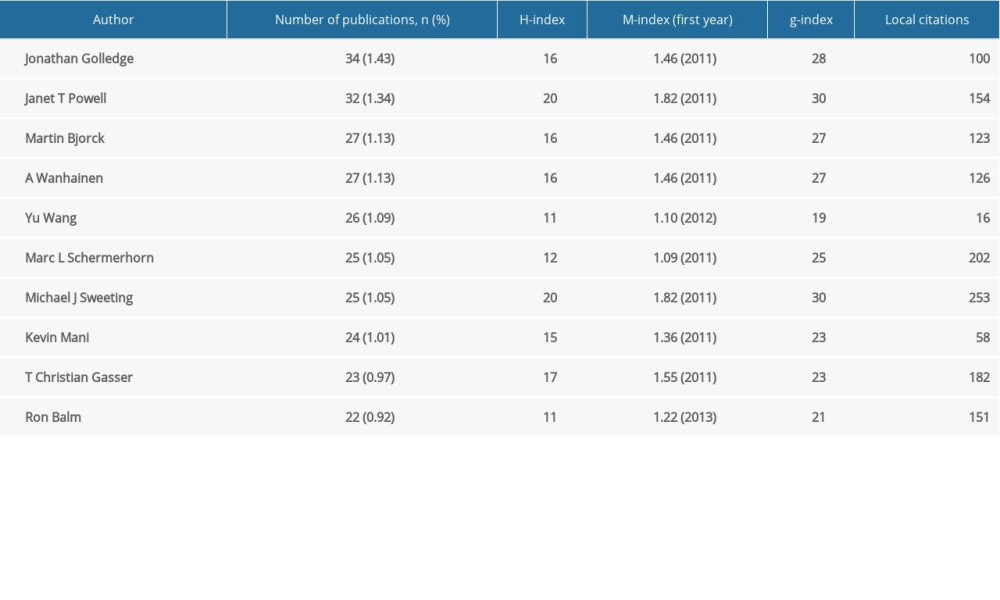 Table 1. Top 10 authors with the highest number of published papers.
Table 1. Top 10 authors with the highest number of published papers.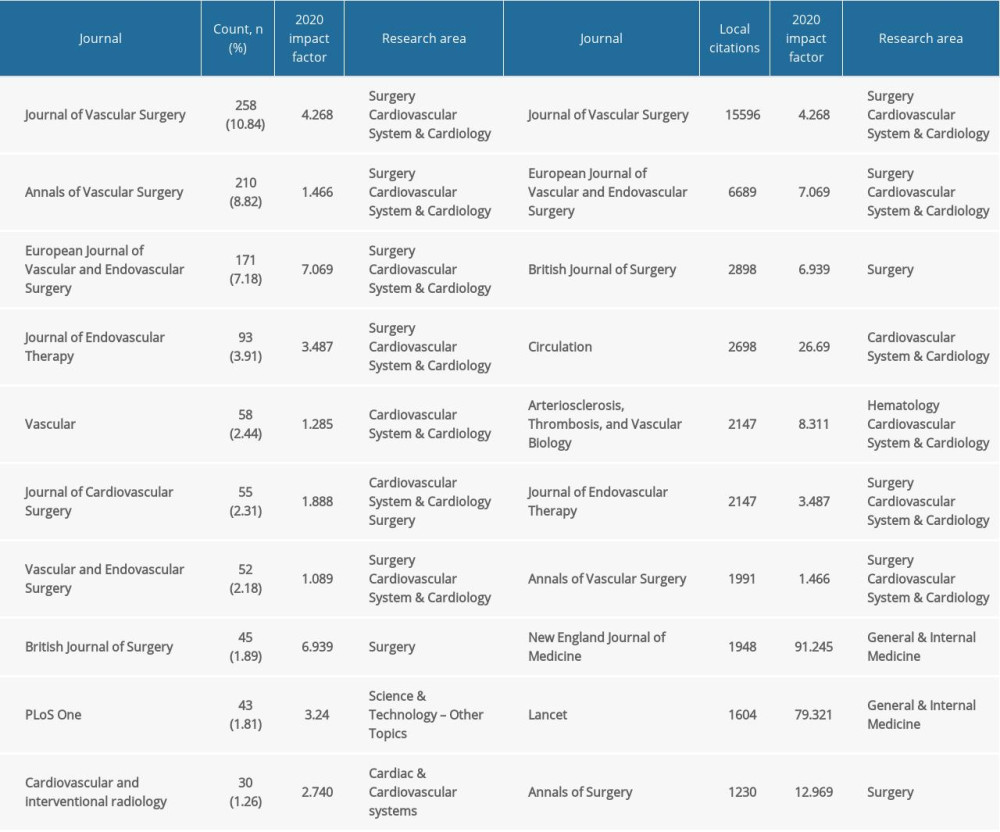 Table 2. Top 10 journals in terms of number of publications and local citations.
Table 2. Top 10 journals in terms of number of publications and local citations.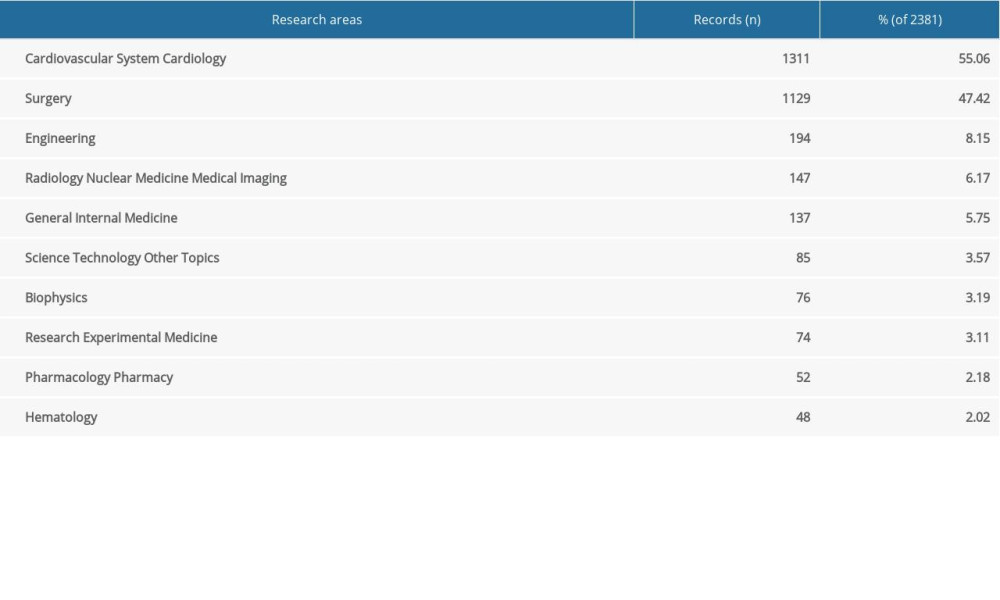 Table 3. Top 10 research areas.
Table 3. Top 10 research areas. Table 1. Top 10 authors with the highest number of published papers.
Table 1. Top 10 authors with the highest number of published papers. Table 2. Top 10 journals in terms of number of publications and local citations.
Table 2. Top 10 journals in terms of number of publications and local citations. Table 3. Top 10 research areas.
Table 3. Top 10 research areas. In Press
06 Mar 2024 : Clinical Research
Comparison of Outcomes between Single-Level and Double-Level Corpectomy in Thoracolumbar Reconstruction: A ...Med Sci Monit In Press; DOI: 10.12659/MSM.943797
21 Mar 2024 : Meta-Analysis
Economic Evaluation of COVID-19 Screening Tests and Surveillance Strategies in Low-Income, Middle-Income, a...Med Sci Monit In Press; DOI: 10.12659/MSM.943863
10 Apr 2024 : Clinical Research
Predicting Acute Cardiovascular Complications in COVID-19: Insights from a Specialized Cardiac Referral Dep...Med Sci Monit In Press; DOI: 10.12659/MSM.942612
06 Mar 2024 : Clinical Research
Enhanced Surgical Outcomes of Popliteal Cyst Excision: A Retrospective Study Comparing Arthroscopic Debride...Med Sci Monit In Press; DOI: 10.12659/MSM.941102
Most Viewed Current Articles
17 Jan 2024 : Review article
Vaccination Guidelines for Pregnant Women: Addressing COVID-19 and the Omicron VariantDOI :10.12659/MSM.942799
Med Sci Monit 2024; 30:e942799
14 Dec 2022 : Clinical Research
Prevalence and Variability of Allergen-Specific Immunoglobulin E in Patients with Elevated Tryptase LevelsDOI :10.12659/MSM.937990
Med Sci Monit 2022; 28:e937990
16 May 2023 : Clinical Research
Electrophysiological Testing for an Auditory Processing Disorder and Reading Performance in 54 School Stude...DOI :10.12659/MSM.940387
Med Sci Monit 2023; 29:e940387
01 Jan 2022 : Editorial
Editorial: Current Status of Oral Antiviral Drug Treatments for SARS-CoV-2 Infection in Non-Hospitalized Pa...DOI :10.12659/MSM.935952
Med Sci Monit 2022; 28:e935952








